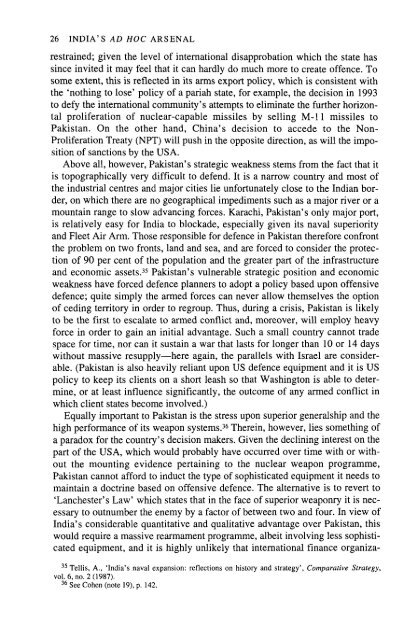India's Ad Hoc Arsenal - Publications - SIPRI
India's Ad Hoc Arsenal - Publications - SIPRI
India's Ad Hoc Arsenal - Publications - SIPRI
- No tags were found...
Create successful ePaper yourself
Turn your PDF publications into a flip-book with our unique Google optimized e-Paper software.
26 INDIA'S AD HOC ARSENALrestrained; given the level of international disapprobation which the state hassince invited it may feel that it can hardly do much more to create offence. Tosome extent, this is reflected in its arms export policy, which is consistent withthe 'nothing to lose' policy of a pariah state, for example, the decision in 1993to defy the international community's attempts to eliminate the further horizontalproliferation of nuclear-capable missiles by selling M-l l missiles toPakistan. On the other hand, China's decision to accede to the NonproliferationTreaty (NPT) will push in the opposite direction, as will the impositionof sanctions by the USA.Above all, however, Pakistan's strategic weakness stems from the fact that itis topographically very difficult to defend. It is a narrow country and most ofthe industrial centres and major cities lie unfortunately close to the Indian border,on which there are no geographical impediments such as a major river or amountain range to slow advancing forces. Karachi, Pakistan's only major port,is relatively easy for India to blockade, especially given its naval superiorityand Fleet Air Arm. Those responsible for defence in Pakistan therefore confrontthe problem on two fronts, land and sea, and are forced to consider the protectionof 90 per cent of the population and the greater part of the infrastructureand economic assets.35 Pakistan's vulnerable strategic position and economicweakness have forced defence planners to adopt a policy based upon offensivedefence; quite simply the armed forces can never allow themselves the optionof ceding territory in order to regroup. Thus, during a crisis, Pakistan is likelyto be the first to escalate to armed conflict and, moreover, will employ heavyforce in order to gain an initial advantage. Such a small country cannot tradespace for time, nor can it sustain a war that lasts for longer than 10 or 14 dayswithout massive resupply-here again, the parallels with Israel are considerable.(Pakistan is also heavily reliant upon US defence equipment and it is USpolicy to keep its clients on a short leash so that Washington is able to determine,or at least influence significantly, the outcome of any armed conflict inwhich client states become involved.)Equally important to Pakistan is the stress upon superior generalship and thehigh performance of its weapon systems.36 Therein, however, lies something ofa paradox for the country's decision makers. Given the declining interest on thepart of the USA, which would probably have occurred over time with or withoutthe mounting evidence pertaining to the nuclear weapon programme,Pakistan cannot afford to induct the type of sophisticated equipment it needs tomaintain a doctrine based on offensive defence. The alternative is to revert to'Lanchester's Law' which states that in the face of superior weaponry it is necessaryto outnumber the enemy by a factor of between two and four. In view of<strong>India's</strong> considerable quantitative and qualitative advantage over Pakistan, thiswould require a massive rearmament programme, albeit involving less sophisticatedequipment, and it is highly unlikely that international finance organiza-35 Tellis, A., '<strong>India's</strong> naval expansion: reflections on history and strategy', Comparative Strategy,vol. 6, no. 2 (1987).36 See Cohen (note 19), p. 142.
















